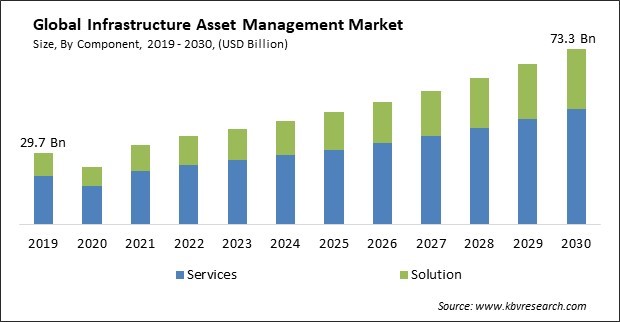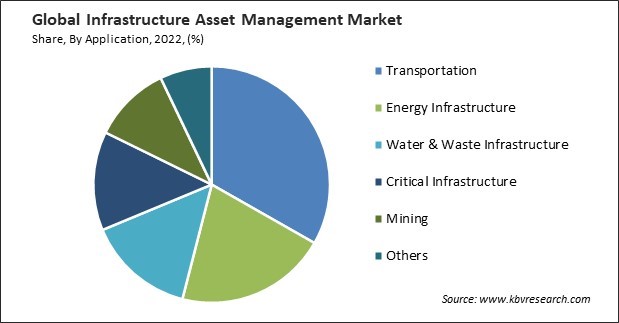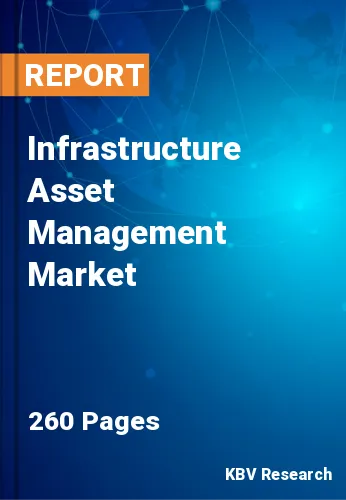The Global Infrastructure Asset Management Market size is expected to reach $73.3 billion by 2030, rising at a market growth of 9.1% CAGR during the forecast period.
Transportation infrastructure is the backbone of modern economies, enabling the movement of goods and people. Thus, transportation segment acquired $12,261.1 million in 2022. The transportation segment encompasses many infrastructure assets, such as roads, bridges, tunnels, railways, and airports. Managing this extensive asset base requires robust practices and solutions. Efficient and well-maintained transportation assets are vital for economic growth and global competitiveness. Some of the factors impacting the market are Expansion of public safety and reliability, Rapid population growth and urbanization and Lack of standardization in IAM technology.

The reliable operation of infrastructure assets is vital for public safety and the uninterrupted provision of essential services. Asset management ensures asset reliability and minimizes the risk of accidents and disruptions. Reliable infrastructure assets are crucial for providing essential services without interruption. Asset management practices help organizations optimize asset performance, reduce downtime, and ensure the continuous provision of services. Additionally, As the population grows and urbanizes, there is a higher demand for essential infrastructure services, including transportation, water supply, energy distribution, and public facilities. Asset management is essential for efficient and sustainable services to meet the increased demand. Rapid urbanization leads to the development of new urban infrastructure, including roads, bridges, public transit, and utilities. Asset management is crucial for planning, constructing, and maintaining these new assets efficiently. As a result of the rising population growth and urbanization, the market is anticipated to increase significantly.
However, the absence of standardized practices and terminology in asset management can lead to confusion and inefficiencies. Developing and adopting standardized guidelines is a complex task. The lack of standardization can result in data incompatibility. Asset data collected and maintained by different organizations are not easily integrated or compared, making it difficult to establish a comprehensive view of the asset portfolio. Lack of standardization can result in higher implementation and operational costs. Customized solutions required to manage non-standardized data and processes, increasing expenses. Lack of standardization is a significant challenge that hampers the growth of the market.
On the basis of application, the market is divided into transportation, energy infrastructure, water & waste infrastructure, critical infrastructure, mining, and others. The energy infrastructure segment garnered a significant revenue share in the infrastructure asset management market in 2022. The energy infrastructure segment encompasses various assets, from conventional power plants to renewable energy installations and electrical grids. Effective asset management is crucial for the performance and reliability of these assets. The energy sector has grown in its asset base due to the emerging prominence of renewable energy sources, including wind, solar, and hydroelectric power. Asset management practices are vital for the optimization and long-term sustainability of renewable energy assets.

By component, the market is categorized into solution and services. The solution segment covered a considerable revenue share in the market in 2022. Asset management solutions facilitate the collection, storage, and retrieval of data related to infrastructure assets. This leads to better organization and accessibility of asset information, allowing for more informed decision-making. Asset management solutions often incorporate data analytics and predictive maintenance capabilities. This enables organizations to analyze historical and real-time data to predict maintenance needs and optimize asset performance, reducing downtime and extending asset lifespans. Many solutions offer real-time monitoring of asset performance and conditions.
Based on services type, the market is classified into strategic asset management, operational asset management, and tactical asset management. In 2022, the operational asset management segment witnessed the largest revenue share in the market. Effective operational asset management improves asset performance, ensuring infrastructure assets operate at maximum capacity. This results in increased efficiency, decreased downtime, and asset owners receiving a greater return on investment. Proper maintenance and care of infrastructure assets lead to an extended lifespan. As assets last longer, asset owners can defer capital expenditures for replacements, ultimately saving money. Proper asset maintenance and operation lead to safer working conditions and reduced risks associated with asset failures. This is particularly important for assets with safety-critical functions.
| Report Attribute | Details |
|---|---|
| Market size value in 2022 | USD 36.9 Billion |
| Market size forecast in 2030 | USD 73.3 Billion |
| Base Year | 2022 |
| Historical Period | 2019 to 2021 |
| Forecast Period | 2023 to 2030 |
| Revenue Growth Rate | CAGR of 9.1% from 2023 to 2030 |
| Number of Pages | 256 |
| Number of Table | 370 |
| Report coverage | Market Trends, Revenue Estimation and Forecast, Segmentation Analysis, Regional and Country Breakdown, Porter’s 5 Forces Analysis, Company Profiling, Companies Strategic Developments, SWOT Analysis, Winning Imperatives |
| Segments covered | Component, Application, Region |
| Country scope |
|
| Companies Included | Golder Associates (WSP Global Inc.), Tetra Laval International S.A, Clarios, LLC. (Brookfield Business Partners), Macquarie Group Limited, SIMCO Technologies, Pitney Bowes, Inc., SNC-Lavalin Group, Inc., Aabasoft Technologies Pvt. Ltd., ThomasLloyd Global Asset Management GmbH, EverStream Capital Management. |
| Growth Drivers |
|
| Restraints |
|
Region-wise, the market is analysed across North America, Europe, Asia Pacific, and LAMEA. In 2022, the North America region led the market by generating the highest revenue share. North America has many aging infrastructure assets, including roads, bridges, water and wastewater systems, energy facilities, and public buildings. North America is a hub for technological innovation, extending to asset management. The region has seen the adoption of cutting-edge technologies such as IoT sensors, data analytics, GIS, and predictive maintenance tools to optimize asset performance. The transportation sector in North America, including roads, bridges, and transit systems, is a significant focus for asset management, as it plays a critical role in the region's economic activity and connectivity.
Free Valuable Insights: Global Infrastructure Asset Management Market size to reach USD 73.3 Billion by 2030
The market research report covers the analysis of key stake holders of the market. Key companies profiled in the report include Golder Associates (WSP Global Inc.), Tetra Laval International S.A, Clarios, LLC. (Brookfield Business Partners), Macquarie Group Limited, SIMCO Technologies, Pitney Bowes, Inc., SNC-Lavalin Group, Inc., Aabasoft Technologies Pvt. Ltd., ThomasLloyd Global Asset Management GmbH, EverStream Capital Management.
By Component
By Application
By Geography
This Market size is expected to reach $73.3 billion by 2030.
Expansion of public safety and reliability are driving the Market in coming years, however, Lack of standardization in IAM technology restraints the growth of the Market.
Golder Associates (WSP Global Inc.), Tetra Laval International S.A, Clarios, LLC. (Brookfield Business Partners), Macquarie Group Limited, SIMCO Technologies, Pitney Bowes, Inc., SNC-Lavalin Group, Inc., Aabasoft Technologies Pvt. Ltd., ThomasLloyd Global Asset Management GmbH, EverStream Capital Management.
The expected CAGR of this Market is 9.1% from 2023 to 2030.
The Services segment acquired the maximum revenue in the Market by Component in 2022; there by, achieving a market value of $48.1 billion by 2030.
The North America region dominated the Market by Region in 2022 and would continue to be a dominant market till 2030; there by, achieving a market value of $25.1 billion by 2030.
Our team of dedicated experts can provide you with attractive expansion opportunities for your business.

